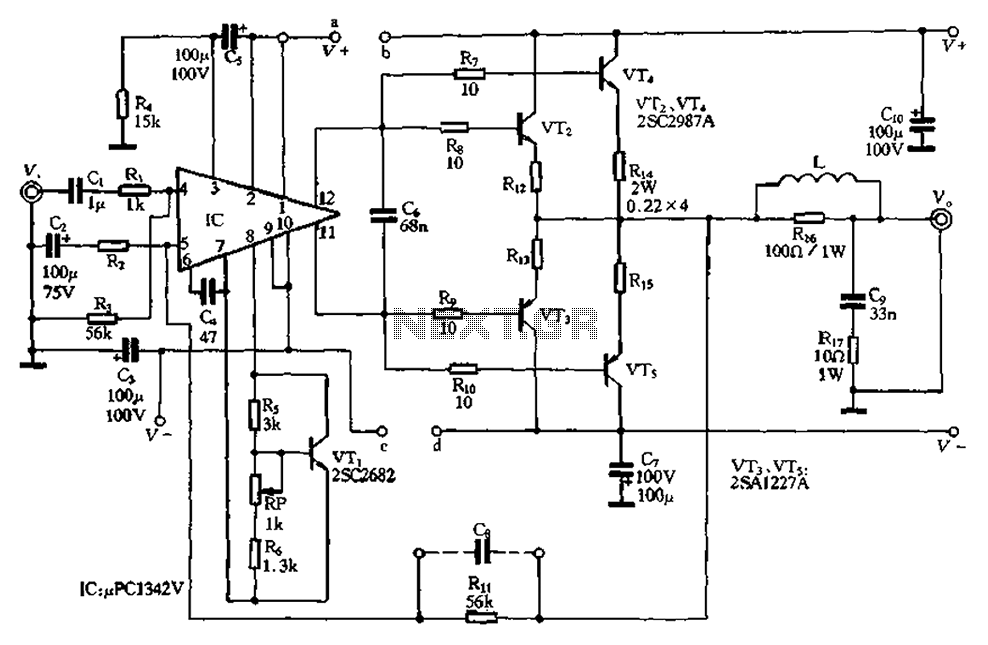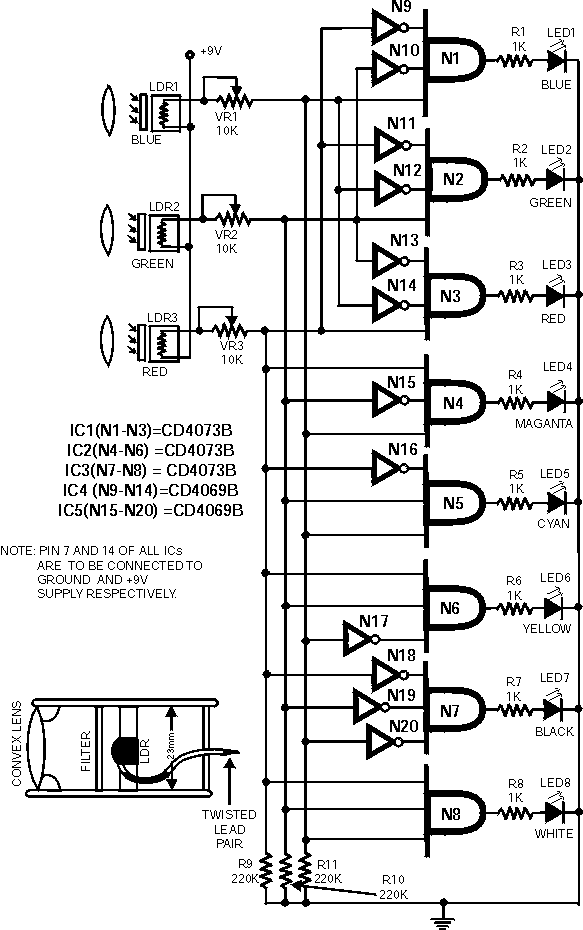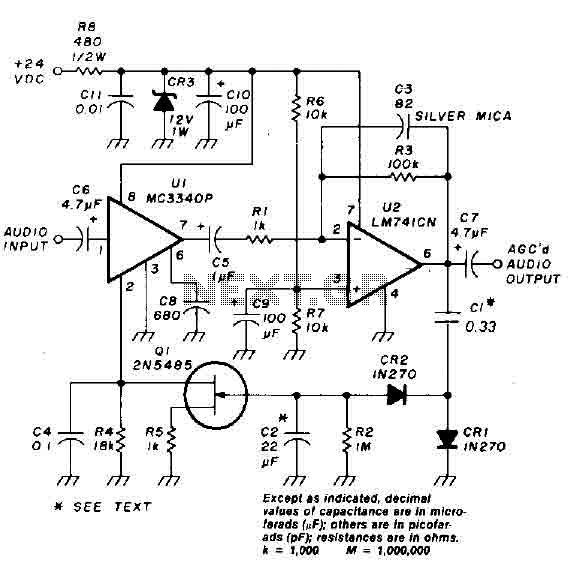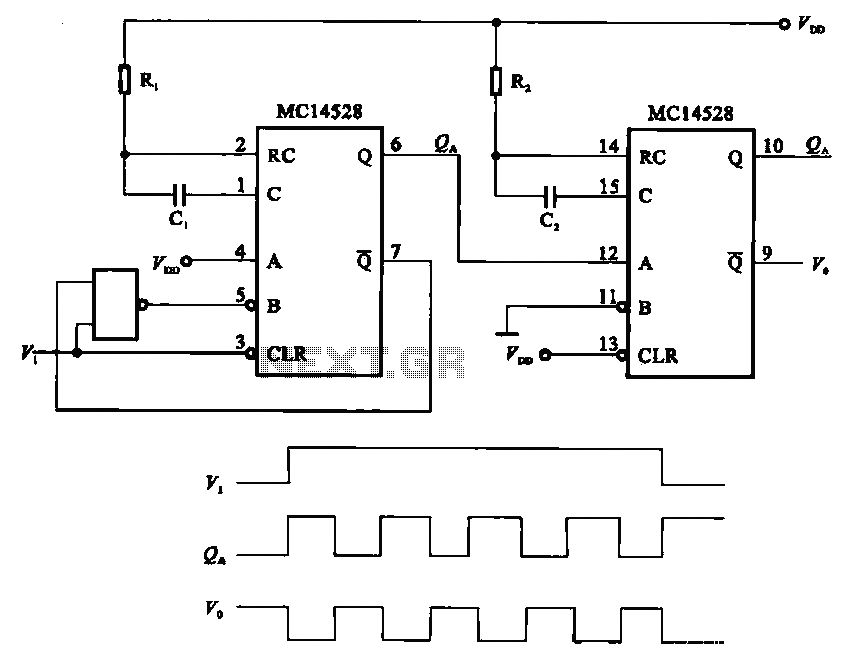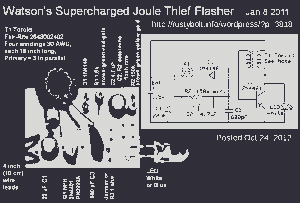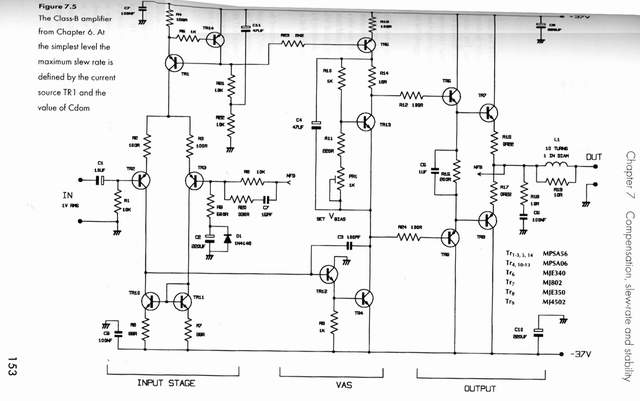
Power Supply Circuit
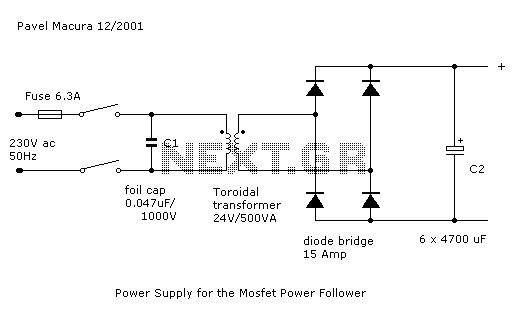
The circuit comprises an N-MOSFET voltage follower (T1, common drain) and a current source (T2, NPN Darlington). The current source is set to 2.2 Amps. With a supply voltage of 40V, the circuit can deliver approximately 17W into an 8 Ohm loudspeaker, while drawing 88W from the power supply. The bandwidth (-3dB) ranges from 4Hz to 250kHz, with a rise time of 1.5 µs. The output resistance is 0.16 Ohm, and the circuit exhibits high tolerance to various load types. The input resistance is 10 kOhm (R0), which can be increased to 100 kOhm (R4) if R0 is omitted. The input capacitance is approximately 1500 pF, necessitating that the preamp output impedance does not exceed 1 kOhm to maintain a high-frequency limit of around 100 kHz. An input potentiometer can replace R0; if a 5 kOhm potentiometer is used, the high-frequency limit drops to about 70 kHz. The power follower can connect directly to the output of a CD player, and a 5 kOhm potentiometer can be employed for volume reduction. Rod Elliott's DoZ preamp is referenced, and an article detailing the MOSFET power follower's use with this preamp is available as "Project 83." The schematic of the modified DoZ preamp can be found in Fig. 2. To meet the specifications of transistors Q1-Q3, a supply voltage of +Vs should be 30V, although experiments indicate they can withstand up to 40V. The use of BC547/BC557 transistors, rated at 45V, is recommended. When connecting the DoZ and the follower, R0 must be omitted. A slightly modified circuit is illustrated in Fig. 3, while the complete amplifier is shown in Fig. 4. The gain is 3.2, requiring nearly 4V RMS input for full power. To increase gain, R4 can be reduced to 1k, achieving a gain of up to 23 (27 dB), with C3 increased to 47µF. Gain can be calculated as G = 1 + (R5/R4). The distortion figure presents the harmonic distortion curve from 15 milliwatts to 6 Watts at 1.8kHz and 8 Ohms for the 7W version of the follower with the DoZ preamp, mainly exhibiting second harmonic distortion. It is advisable to lower the supply voltage or quiescent current if the heatsink is inadequate; 30V supply voltage yields about 10W into 8 Ohms. R7 is utilized to adjust the current through a 3V zener diode to maintain the appropriate quiescent current through R6. This current (from constant current source T2) can be measured by the voltage drop in Volts across R6, which equals the current through T2 in Amps due to R6's value (1 Ohm). Reducing the quiescent current to 1.4 A (at 40V supply voltage) results in approximately 8W into 8 Ohms. Caution is advised regarding the zener voltage of ZD3V; the BZX83 type (0.5W, 3V) zener diode is recommended, providing a zener voltage between 3.0V and 3.3V. Using a larger diode (1.3W, 2W, etc.) may yield a different zener voltage, leading to incorrect quiescent current in the follower. Always verify the zener voltage in the actual circuit. The quiescent current is calculated as (zener voltage - Vbe of T2)/R6, and the voltage across R6 should be monitored, as it directly relates to the quiescent current.
The circuit operates as a high-fidelity audio amplifier, leveraging the characteristics of the N-MOSFET and NPN Darlington configurations to achieve low output resistance and high power efficiency. The N-MOSFET voltage follower configuration allows for high input impedance and low output impedance, making it suitable for driving loads such as loudspeakers. The Darlington pair serves as a robust current source, maintaining a steady output current even under varying load conditions.
The design emphasizes thermal management, suggesting that if the heatsink is not sufficient, adjustments to the supply voltage or quiescent current may be necessary to prevent overheating. The choice of transistors also plays a crucial role in ensuring reliability and performance under specified operating conditions. The circuit’s bandwidth and rise time indicate its capability to handle a wide range of audio frequencies without significant distortion, making it ideal for high-quality audio applications.
The inclusion of a potentiometer for volume control adds versatility to the circuit, allowing users to adjust the output level according to their preferences. Overall, the design is aimed at providing a powerful, efficient, and reliable audio amplification solution suitable for various audio applications.The circuit consists of N-MOSFET voltage follower T1 (common Drain) and current source T2 (NPN Darlington). Current source is set to 2. 2 Amps. With 40V of supply voltage the circuit is able to deliver about 17W into 8 Ohm loudspeaker. But takes 88W from power supply anytime. Bandwidth (-3dB) is from 4Hz to 250kHz. Rise time is 1. 5 us. Output resis tance 0. 16 Ohm. The circuit is very tolerant to different kinds of load. Input resistance is 10 kOhm (R0), but can be increased up to 100 kOhm (R4) when omitting R0. Input capacitance remains high, about 1500 pF. For this reason, the preamp should not have higher output impedance than 1 kOhm to maintain high frequency limit about 100 kHz. An input potentiometer can be used instead of R0. If the value of the potentiometer is 5 kOhm then the high frequency limit will be about 70 kHz. The power follower can be connected directly to the output of CD player and for reduction of volume the potentiometer 5 kOhm can be used.
Rod Elliott`s DoZ preamp is used (see or ). An article describing the use of this MOSFET power follower with Rod`s preamp can be seen at as "Project 83". The schematic of the DoZ preamp ( ©Rod Elliot, ESP, see his pages, and you can also order PCB`s for the DoZ from him.
) modified for this purpose can be seen in Fig. 2. To fulfill the specs of Q1-Q3 transistors, a supply voltage +Vs should be 30V. An experiment shows that they will survive supply voltage of 40V, so it is up to you to make a decision. It might be better to use BC547/BC557 as they are rated at 45V. When interconnecting the DoZ and the Follower, it is necessary to omit the R0 resistor of the follower.
This slightly modified circuit can be seen in Fig. 3. The complete amplifier is shown in Fig. 4. As shown, the gain is 3. 2, so it will require nearly 4V RMS input for full power. To increase the gain, you can change the R4 of the DoZ down to 1k to obtain a gain up to 23 (27 dB). Then increase the value of C3 to 47uF. The gain can be calculated as G = 1 + (R5/R4). Distortion figure shows the harmonic distortion curve from 15 milliwats to 6 Watts at 1. 8kHz and 8 Ohms for 7W version of the Follower with DoZ preamp. The distortion is mostly second harmonic. P. S. You may reduce the supply voltage or quiescent current if your heatsink is not good enough. 30V of supply voltage will give you about 10W/8 Ohm. R7 will be then used to trim a current through zener diode 3V to maintain appropriate quiescent current through R6. This current (the current of constant current source T2) can be easily measured - a voltage drop in Volts accross R6 resistor has the same value as the current through T2 in Amps, because of the R6 value (1 Ohm).
In case you reduce quiescent current to 1. 4 A (at 40V of supply voltage) you will get about 8W/8 Ohm. Take care about zener voltage of the ZD3V. I use the BZX83 type, 0. 5W, 3V zener diode. This diode gives proper zener voltage between 3. 0V to 3. 3V. In case you use bigger diode (1. 3W, 2W etc. ), most likely you will get different zener voltage, resulting in wrong quiescent current of the follower. Always check the zener voltage in this real circuit! The quiescent current equals (zener voltage - Vbe of T2)/R6. And check voltage across R6, as quiescent current is 🔗 External reference
The circuit operates as a high-fidelity audio amplifier, leveraging the characteristics of the N-MOSFET and NPN Darlington configurations to achieve low output resistance and high power efficiency. The N-MOSFET voltage follower configuration allows for high input impedance and low output impedance, making it suitable for driving loads such as loudspeakers. The Darlington pair serves as a robust current source, maintaining a steady output current even under varying load conditions.
The design emphasizes thermal management, suggesting that if the heatsink is not sufficient, adjustments to the supply voltage or quiescent current may be necessary to prevent overheating. The choice of transistors also plays a crucial role in ensuring reliability and performance under specified operating conditions. The circuit’s bandwidth and rise time indicate its capability to handle a wide range of audio frequencies without significant distortion, making it ideal for high-quality audio applications.
The inclusion of a potentiometer for volume control adds versatility to the circuit, allowing users to adjust the output level according to their preferences. Overall, the design is aimed at providing a powerful, efficient, and reliable audio amplification solution suitable for various audio applications.The circuit consists of N-MOSFET voltage follower T1 (common Drain) and current source T2 (NPN Darlington). Current source is set to 2. 2 Amps. With 40V of supply voltage the circuit is able to deliver about 17W into 8 Ohm loudspeaker. But takes 88W from power supply anytime. Bandwidth (-3dB) is from 4Hz to 250kHz. Rise time is 1. 5 us. Output resis tance 0. 16 Ohm. The circuit is very tolerant to different kinds of load. Input resistance is 10 kOhm (R0), but can be increased up to 100 kOhm (R4) when omitting R0. Input capacitance remains high, about 1500 pF. For this reason, the preamp should not have higher output impedance than 1 kOhm to maintain high frequency limit about 100 kHz. An input potentiometer can be used instead of R0. If the value of the potentiometer is 5 kOhm then the high frequency limit will be about 70 kHz. The power follower can be connected directly to the output of CD player and for reduction of volume the potentiometer 5 kOhm can be used.
Rod Elliott`s DoZ preamp is used (see or ). An article describing the use of this MOSFET power follower with Rod`s preamp can be seen at as "Project 83". The schematic of the DoZ preamp ( ©Rod Elliot, ESP, see his pages, and you can also order PCB`s for the DoZ from him.
) modified for this purpose can be seen in Fig. 2. To fulfill the specs of Q1-Q3 transistors, a supply voltage +Vs should be 30V. An experiment shows that they will survive supply voltage of 40V, so it is up to you to make a decision. It might be better to use BC547/BC557 as they are rated at 45V. When interconnecting the DoZ and the Follower, it is necessary to omit the R0 resistor of the follower.
This slightly modified circuit can be seen in Fig. 3. The complete amplifier is shown in Fig. 4. As shown, the gain is 3. 2, so it will require nearly 4V RMS input for full power. To increase the gain, you can change the R4 of the DoZ down to 1k to obtain a gain up to 23 (27 dB). Then increase the value of C3 to 47uF. The gain can be calculated as G = 1 + (R5/R4). Distortion figure shows the harmonic distortion curve from 15 milliwats to 6 Watts at 1. 8kHz and 8 Ohms for 7W version of the Follower with DoZ preamp. The distortion is mostly second harmonic. P. S. You may reduce the supply voltage or quiescent current if your heatsink is not good enough. 30V of supply voltage will give you about 10W/8 Ohm. R7 will be then used to trim a current through zener diode 3V to maintain appropriate quiescent current through R6. This current (the current of constant current source T2) can be easily measured - a voltage drop in Volts accross R6 resistor has the same value as the current through T2 in Amps, because of the R6 value (1 Ohm).
In case you reduce quiescent current to 1. 4 A (at 40V of supply voltage) you will get about 8W/8 Ohm. Take care about zener voltage of the ZD3V. I use the BZX83 type, 0. 5W, 3V zener diode. This diode gives proper zener voltage between 3. 0V to 3. 3V. In case you use bigger diode (1. 3W, 2W etc. ), most likely you will get different zener voltage, resulting in wrong quiescent current of the follower. Always check the zener voltage in this real circuit! The quiescent current equals (zener voltage - Vbe of T2)/R6. And check voltage across R6, as quiescent current is 🔗 External reference
